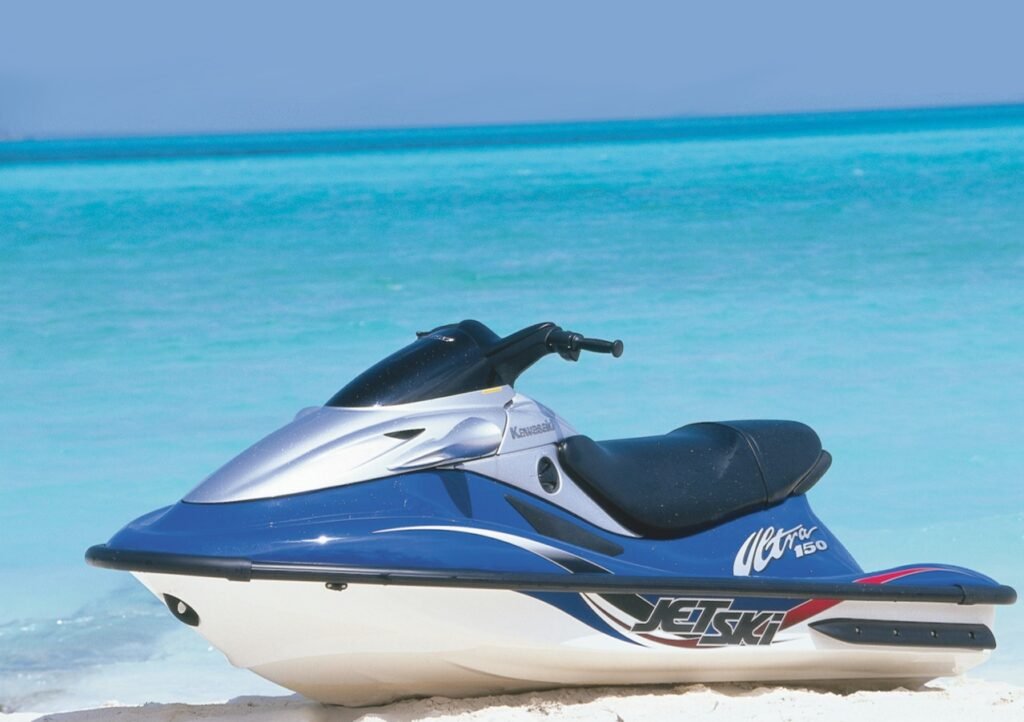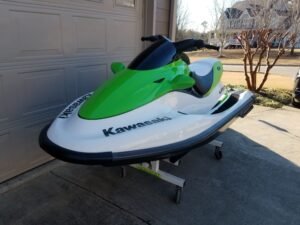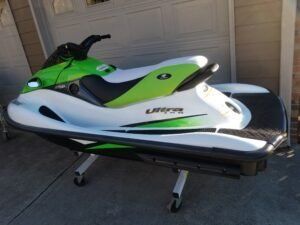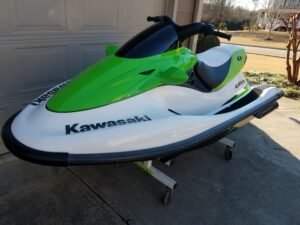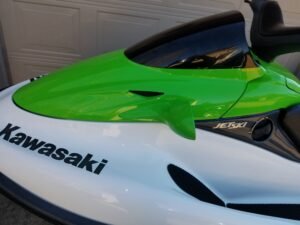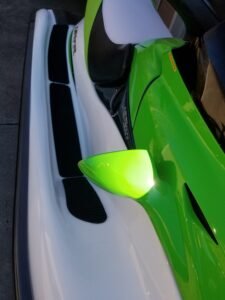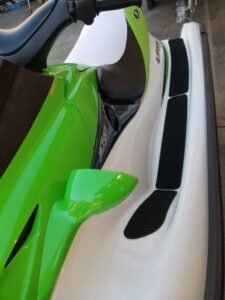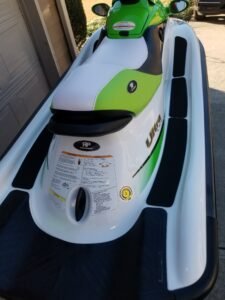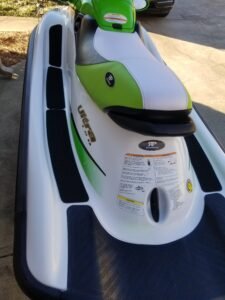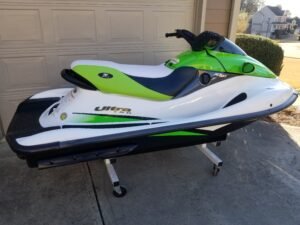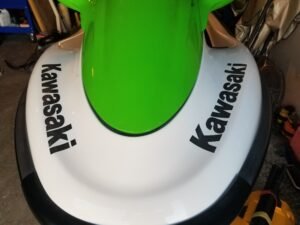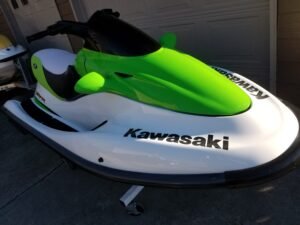This post may contain affiliate links, which means that I may make a small commission off items you purchase at no additional cost to you. Please see my terms of use page for details.
Introduction and History
Let’s take a journey back to the late 90s and early 2000s when the thrill of speeding across the water on a personal watercraft was at its peak. In this era, Kawasaki unveiled the Ultra 150, a high-performance 2-seater personal watercraft that etched a lasting impression in the hearts of water sports enthusiasts. Produced between 1999 and 2005, the Kawasaki Ultra 150 came packed with a remarkable set of features. Sporting a modified ZXi hull and measuring 113.8 inches in length, 44.4 inches in width, and 40.5 inches in height, it was nothing short of impressive.
Underneath the hood, a potent 2-stroke, 1176cc triple cylinder, triple-carbureted engine roared to life, churning out a staggering 145 HP. Among its advanced features were digital instrumentation, adjustable electric trim, and handlebar-mounted start/stop buttons. With a top speed of 65-67 mph and a fuel consumption of 13.3 GPH at full throttle, this watercraft was tailor-made for adrenaline junkies. However, the Ultra 150 was not without its peculiarities.
Notably absent was a reverse system, a detail that some riders found inconvenient. Short-lived pump bearings and aging oil lines were also issues that owners needed to contend with. The 1999 models, in particular, featured a more high-end ignition system that demanded costly spark plugs. Despite these quirks, the Kawasaki Ultra 150 still stood as an exhilarating choice for water sports enthusiasts, offering a unique blend of power and performance.
What made the Kawasaki Ultra 150 special was its innovative design and lightweight hull combined with a robust engine. Its low power-to weight ratio gave it an edge over many competitors of its time. While the Ultra 150 was retired in 2005, it remains a highly sought-after model in the used PWC market due to its legacy as one of the fastest two-stroke jet skis ever built.
Delving deeper into the fascinating realm of the Kawasaki Ultra 150, we will explore its distinctive features, compare different models, and uncover more intriguing details about this thrilling watercraft. In this article, we will explore the manufacturing years, specifications, unique features, top speed, common problems, the introductory 1999 model differences, what makes the Ultra 150 the fastest 2-stroke jetski built, and conclude with a summary of its legacy.
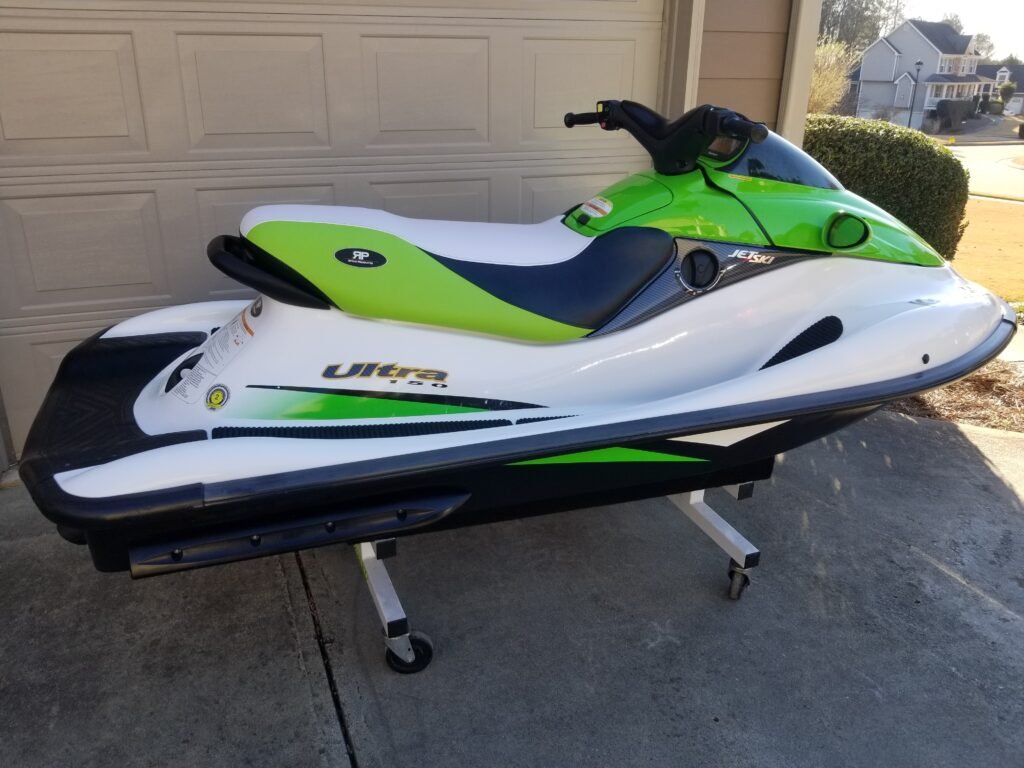
Engine Details
The Kawasaki Ultra 150 is powered by a 1,176cc, three-cylinder, two-stroke engine. This powerhouse features triple Keihin CDCV40-35 carburetors with single fuel pump for efficient fuel delivery and a tuned exhaust system to maximize performance. The engine’s 145 horsepower output made it one of the most powerful two-stroke engines of its time, giving the Ultra 150 its legendary speed and acceleration.
Kawasaki designed this engine to be both high-performing and reliable when maintained correctly. The water-cooled engine is optimized for consistent performance in varying water conditions, while its lightweight construction complements the PWC’s nimble handling. Despite its strengths, some riders reported challenges with fuel consumption and occasional maintenance issues, such as fouled spark plugs, making routine upkeep essential. This engine delivered an exhilarating riding experience, allowing riders to reach impressive high speeds, making it the perfect choice for thrill seekers.
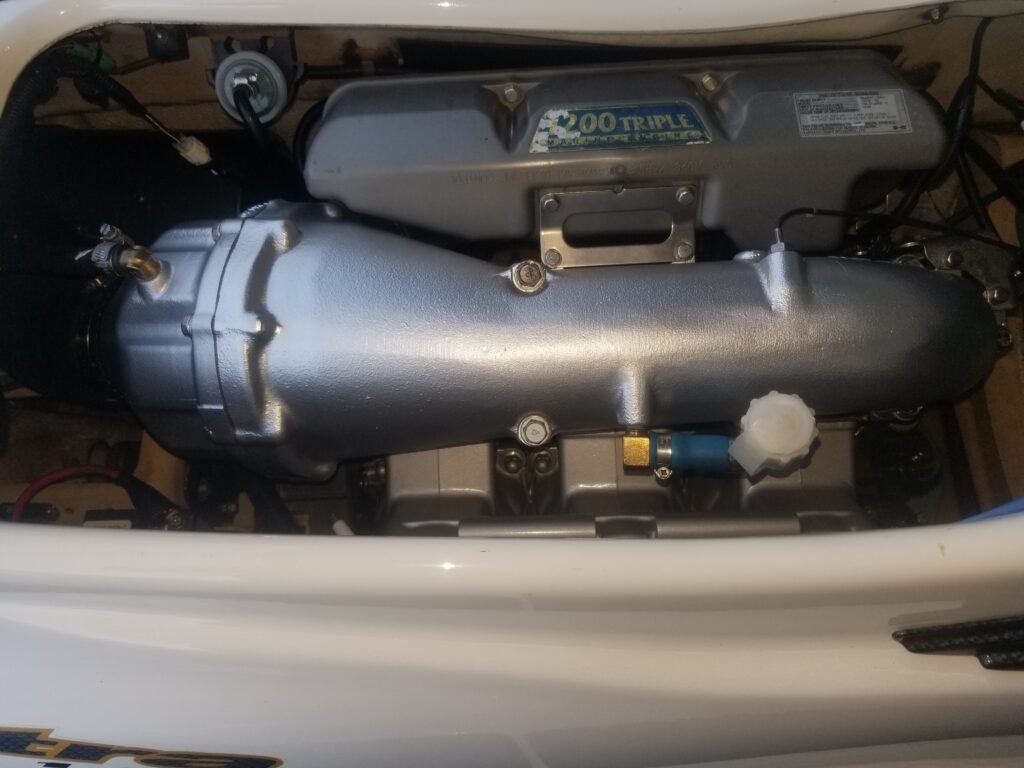
Primary Specifications and Equipment
The Ultra 150’s specifications reflect its focus on speed and performance. With a dry weight of just 626 pounds, it’s relatively light for a 2-seater PWC. It offers a fuel capacity of 15.3 gallons, ensuring enough range for extended rides, though its high-performance engine does tend to consume fuel quickly. Storage is minimal, but the focus on performance makes up for this limitation.
The Ultra 150 also includes basic instrumentation, such as speedometer, tachometer, and fuel gauge, to keep riders informed. Although it lacks the advanced technology found in today’s PWCs, its simplicity appeals to enthusiasts who value raw power and agility.
Hull Material and Design
The hull of the Kawasaki Ultra 150 is crafted from fiberglass reinforced plastic (FRP), which strikes a balance between lightweight construction and durability. Kawasaki opted for a semi-V hull design with integrated sponsons, ensuring sharp cornering and stability at high speeds. The hull’s design is particularly suited for flat-water performance, though it can handle moderate chop with skillful control.
While the lightweight hull contributes to its impressive speed, some riders have noted that it can feel less stable compared to heavier PWCs in rougher waters. Professionals often praise the hull’s agility and responsiveness, making it a favorite for competitive racing.
Unique Features
Modified ZXi Hull
One of the standout features of the Ultra 150 was its modified ZXi hull. This hull design contributed to the personal watercraft’s excellent stability and maneuverability. The modified hull allowed riders to confidently navigate through various water conditions without compromising on speed or control.
Digital Instrumentation
The Kawasaki 1200 Ultra 150 came equipped with digital instrumentation, providing riders with clear and accurate information about the watercraft’s performance. The digital display offered vital details such as speed, engine RPM, fuel levels, and more, allowing riders to stay informed and make necessary adjustments while on the water.
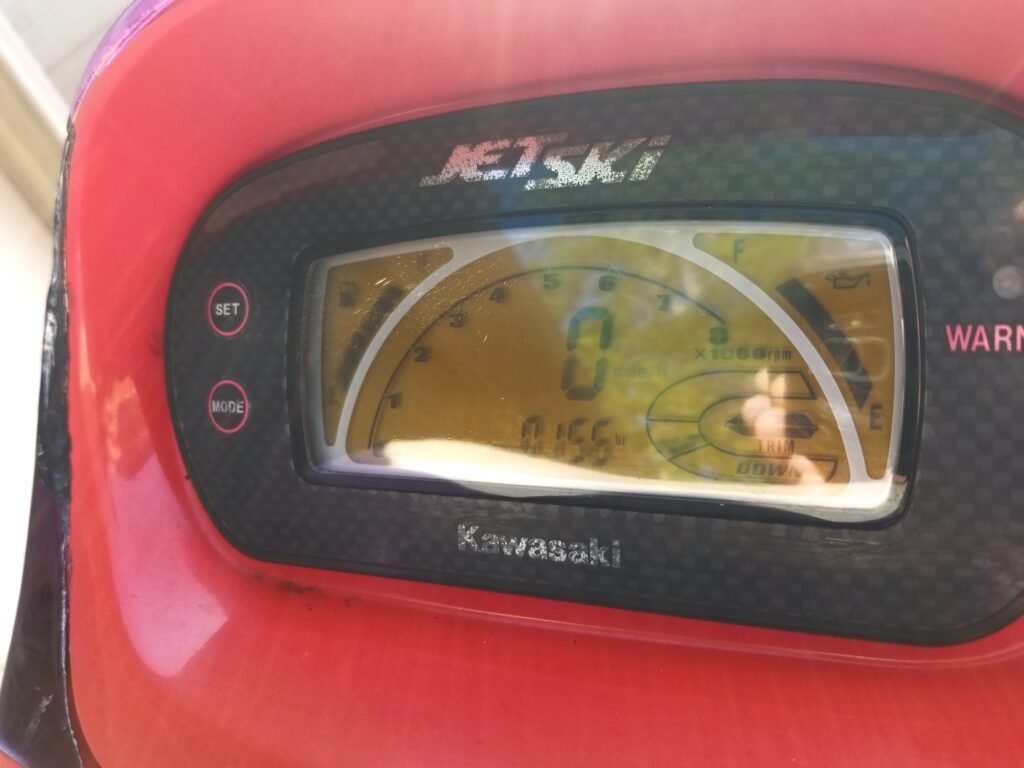
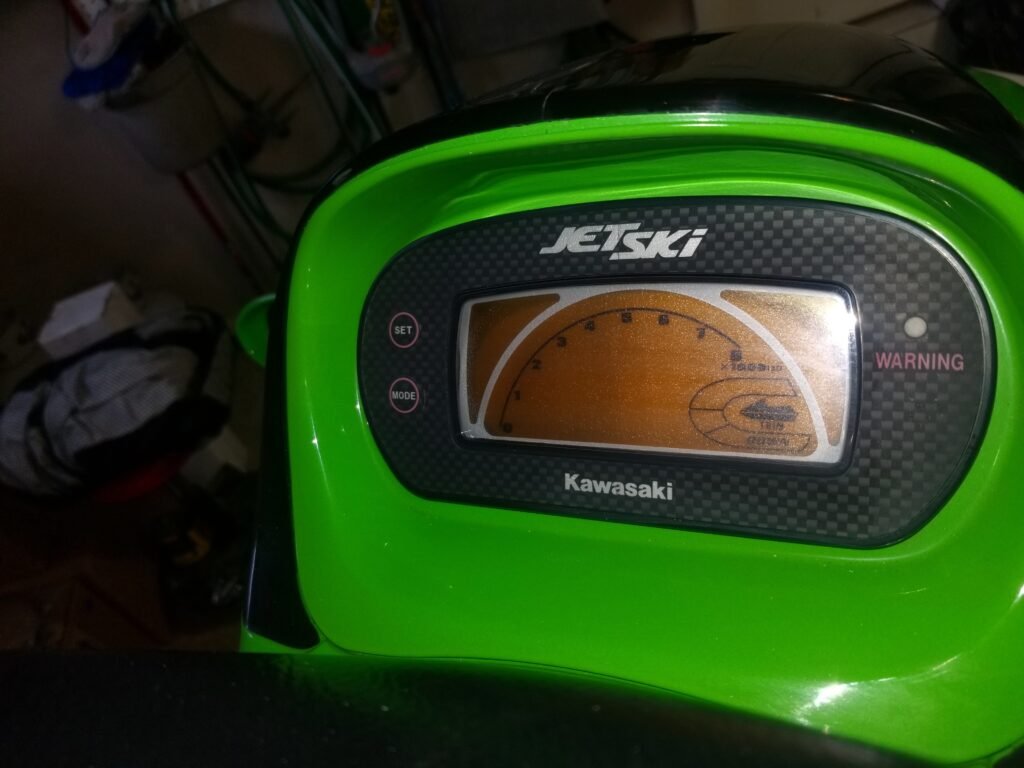
Adjustable Electric Trim
Another notable feature of the Kawasaki Ultra 150 was its adjustable electric trim system. This feature allowed riders to fine-tune the watercraft’s trim angle, providing optimal balance and control in different water conditions. The adjustable electric trim ensured that riders could easily adjust their riding experience to suit their preferences and achieve peak performance.
Handlebar-Mounted Start/Stop Buttons
Convenience was a focus for Kawasaki when designing the Ultra 150, as evidenced by the handlebar-mounted start/stop buttons. This feature allowed riders to easily start or stop the engine with a simple press of a button, eliminating the need to reach down or fumble with controls while on the water. This user-friendly design ensured that riders could quickly and effortlessly control the watercraft.
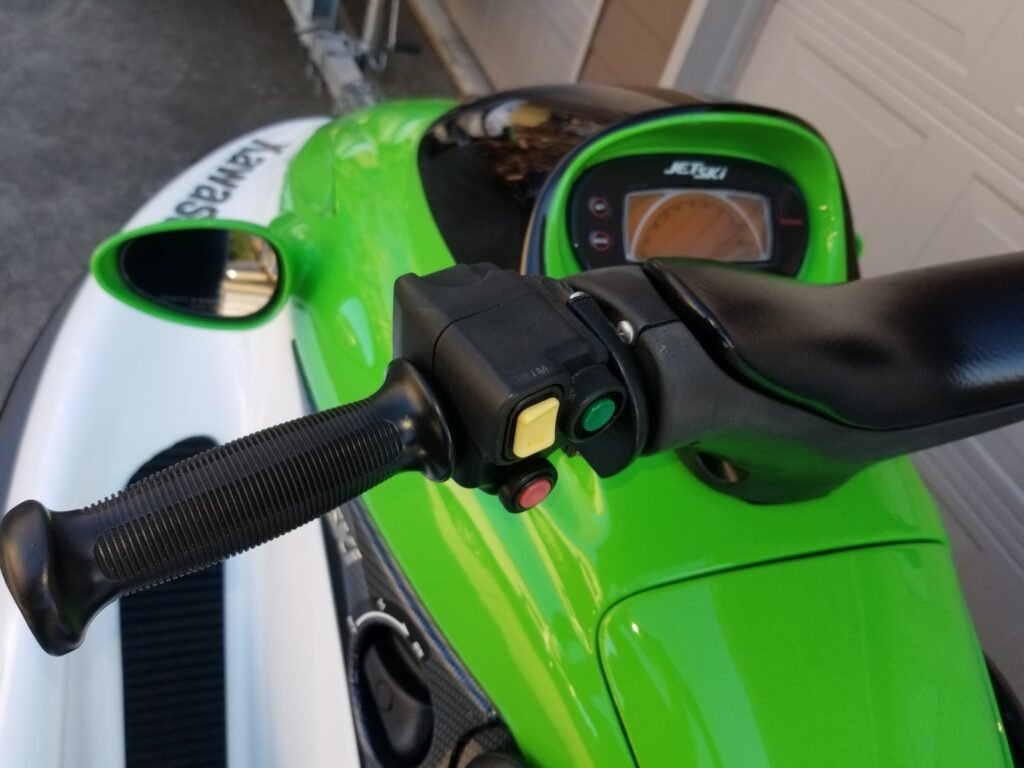
Top Speed
Maximum Speed
The Kawasaki Ultra 150 offered an impressive top speed of 65-67 mph, allowing riders to experience thrilling high-speed adventures on the water. This exceptional speed ensured that riders could enjoy the adrenaline rush that comes with pushing the limits of performance. The maximum speed achieved by this jetski is a testament to its powerful engine and aerodynamic design.
Fuel Consumption
Despite its high-speed capabilities, the Ultra 150 maintained a reasonable fuel consumption rate. At full throttle, the watercraft consumed approximately 13.3 gallons per hour (GPH) at full throttle. This ensured that riders could enjoy longer rides without constantly needing to refuel, enhancing their overall experience on the water.
Common Problems
Lack of Reverse System
One common drawback of the Kawasaki Ultra 150 was the lack of a reverse system. Unlike some other personal watercraft models, the Ultra 150 did not offer the convenience of a reverse system. This meant that riders had to be mindful of their positioning and plan their maneuvers accordingly to avoid unnecessary challenges.
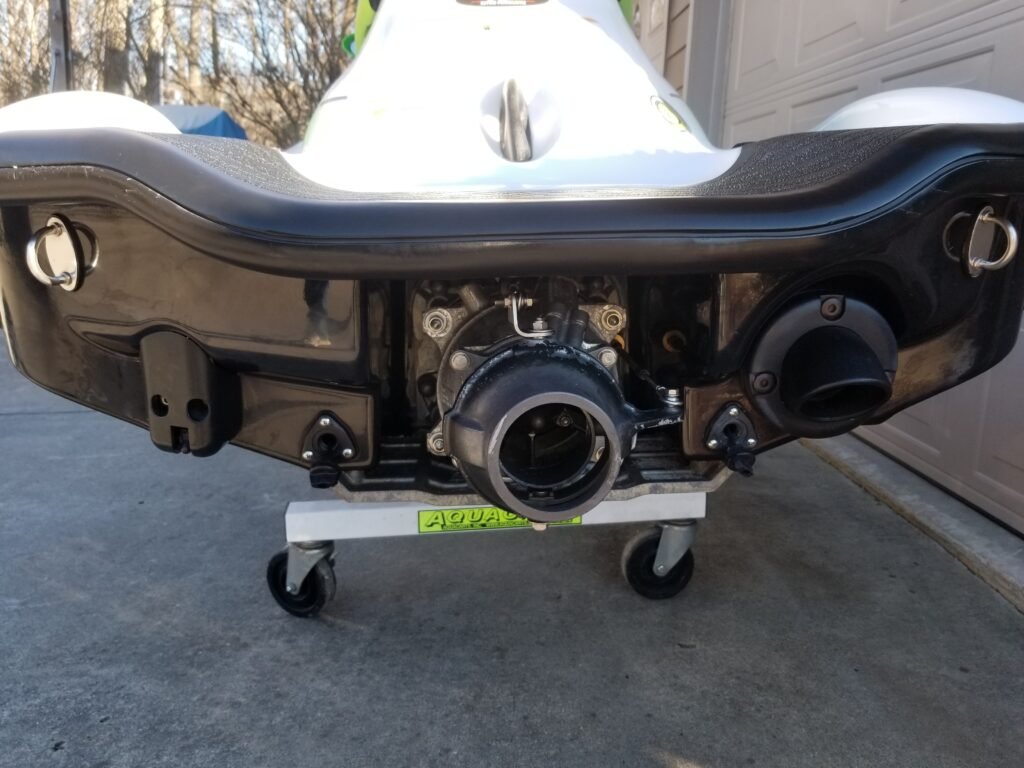
Short-Lived Pump Bearings
Another known issue with the Ultra 150 was the longevity of the pump bearings. Over time, the pump bearings could wear out faster than expected, requiring regular maintenance and replacement. Riders needed to be proactive in monitoring and addressing this issue to ensure the watercraft’s optimal performance.
Aging Oil Lines
The Kawasaki Ultra 150 also had a tendency for its oil lines to show signs of aging. Due to factors such as heat and wear, the oil lines could deteriorate, potentially leading to leaks and compromising the engine’s lubrication system. Regular inspection and maintenance of the oil lines were necessary to prevent any performance or reliability issues and also to prevent catastrophic engine failure.
Model Year Differences
1999 Model Upgraded Ignition System
The 1999 model of the Ultra 150 featured an upgraded ignition system that required the use of more expensive spark plugs. This enhancement improved the watercraft’s ignition performance, making these particular models the fastest among all the Ultra 150 models produced. The upgraded ignition system ensured that riders could enjoy even greater speed and responsiveness on the water.
Comparison with 2000-2005 Models
While the 1999 model of the Kawasaki Ultra 150 boasted a more advanced ignition system which made them the fastest among all the Ultra Jetski models, the 2000-2005 models still offered exceptional performance and reliability. The later models benefitted from various improvements and refinements, ensuring a continued exhilarating riding experience for watercraft enthusiasts. The Kawasaki Ultra 150 was produced between 1999 and 2005. As a result, there are six different model years available to consumers who are interested in purchasing this personal watercraft. Each model year may have slight differences in terms of features and specifications, allowing buyers to choose the one that best suits their preferences and needs.
2005 Kawasaki Ultra 150 Model
The 2005 Kawasaki Ultra 150 marked the final production year for this iconic jet ski, and it came equipped with notable refinements that solidified its reputation as a high-performance watercraft. One standout feature was the inclusion of Kawasaki’s Smart Steering System (KSS), a technology designed to improve control during low-speed maneuvers. KSS activates when the throttle is released, maintaining a slight amount of thrust to assist with steering at idle speeds, such as when docking or navigating tight spaces. This system addressed a common challenge with PWCs, where reduced throttle often led to diminished steering control, making the Ultra 150 safer and easier to handle in these situations.
The Smart Steering System was particularly helpful for less experienced riders or those operating in crowded marinas, as it provided added confidence during low-speed operations. By ensuring consistent steering response, KSS reduced the likelihood of collisions and improved the overall user experience. Although the 2005 model remained largely unchanged in terms of engine and hull design, the integration of KSS demonstrated Kawasaki’s commitment to enhancing rider safety and convenience without compromising the performance that defined the Ultra 150.
In addition to the Smart Steering System, the 2005 Ultra 150 retained its legendary speed, nimble handling, and lightweight design. These characteristics, combined with the thoughtful addition of KSS, made the final model year a fitting farewell to one of the most celebrated two-stroke jet skis in history.
Checkout these two videos of a 2005 Kawasaki Ultra 150 that I completely Rebuilt/ Restored here!
Fastest 2-Stroke Jetski Built
The Kawasaki Ultra 150 earned its place as one of the fastest 2-stroke jetskis ever built. With its powerful engine, advanced hull design, and overall performance capabilities, the watercraft delivered an exhilarating ride that enthusiasts could appreciate. The combination of speed, agility, and performance makes the Ultra 150 a top choice for thrill seekers, racers, and watercraft enthusiasts.
Racing Success
The Kawasaki Ultra 150 also achieved significant success in the world of racing. Its exceptional performance and handling made it a popular choice among professional and amateur racers alike. The watercraft’s capabilities allowed riders to compete at the highest levels, showcasing Kawasaki’s dedication to producing competitive machines.
Safety Features
Although primarily performance-focused, the Kawasaki Ultra 150 includes several essential safety features:
Engine Kill Lanyard: Ensures the engine stops if the rider falls off.
Fire Extinguisher Holder: Provides quick access to a fire extinguisher in emergencies.
Tool Kit: Includes basic tools for on-the-water repairs.
While the Ultra 150 lacks modern safety innovations like electronic brake systems, these fundamental features make it a reliable option for experienced riders.
What Riders Are Saying About the Kawasaki Ultra 150
Positive Reviews:
Performance: Riders rave about the Ultra 150’s speed and acceleration, with many calling it the “ferrari of two-stroke jet skis.”
Handling: The lightweight design and sharp handling make it ideal for tight turns and racing scenarios.
Negative Reviews:
Fuel Consumption: The high-performance engine guzzles fuel quickly, leading to frequent refueling.
Stability in Rough Water: Some riders find it less stable in choppy conditions due to its lightweight design.
Best Accessories Available for the Kawasaki Ultra 150
Enhance your Ultra 150 experience with these top accessories:
Performance Impeller: Improve acceleration and top speed.
Hydro-Turf Mats: Increase grip and comfort.
Aftermarket Sponsons: Enhance cornering stability.
Jet Pump Rebuild Kit: Maintain optimal performance.
Custom Storage Covers: Protect your ski from the elements.
Engine Specifications Table
| Feature | Details |
|---|---|
| Engine Type | 3-cylinder, 2-stroke |
| Horsepower (hp) | 145 hp |
| Top Speed (mph) | 65-67 mph |
| Displacement (mL) | 1,176 mL |
| Cylinder Bore & Stroke (mm) | 80.0 x 78.0 mm |
| Compression Ratio | 5.8:1 |
| # of Cylinders | 3 |
| Cooling System | Water-cooled |
| Fuel System Type | Triple Carbureted |
| Fuel Minimum Octane Rating | 87 |
| Fuel Consumption | 13.3 GPH at Full Throttle |
| Oil Capacity (gal/ quarts) | 1.24 U.S. gal/ 5.0 quarts |
| Lubrication System | Oil injection |
| Ignition | DC CDI |
| Spark Plug Gap (2000-2005 models) | 0.7-0.8 mm (.028-.031 in) |
| Exhaust | Tuned pipe |
Kawasaki Ultra 150 Primary Specifications Table
| Feature | Details |
| Length (“) | 113.8 inches |
| Width (“) | 44.4 inches |
| Height (“) | 40.5 inches |
| Dry Weight (lbs) | 626 lbs |
| Load Capacity (lbs) | 330 lbs |
| Seating Capacity | 2 |
| Storage Capacity (gal) | Minimal Front Storage and Glovebox |
| Fuel Tank Size (gal/liters) | 15.3 U.S. gal/ 58 liters |
| Fuel Reserve Size (gal/liters) | 1.85 U.S. gal/ 7 liters |
| Battery Size/ Number | 12V/ 18Ah / YTX20L-BS |
| Towing Capable (Y/N) | Not Designed For Towing Because It’s a 2 Seater/ Spotter Is Needed |
| Hull Material | Fiberglass |
| Hull Type | Semi-V |
| Body/ Deck Material | Fiberglass |
| Colors Available | Red/ White, Blue/ White, Green/ White, Green/ Black |
| Sponsons | Yes |
| Boarding Step | No |
| Instrumentation | Fuel/ Oil Level, Speedometer, Tachometer, Trim Gauge, Hours |
Sound System (Factory or Accessory)(Included or Not) | (Not Factory)(Not Included) |
| Drive System | Jet Propulsion |
| Trim System | Yes, Electrically Operated |
| Rear View Mirrors (Y/N) | Yes, Factory Equipped |
| Original Selling Price (Base) | $8599.00 (2005 model) |
Kawasaki Ultra 150 Service Item Details and Availability Table
| Product | OEM Part Number | Recommended Link to Buy |
|---|---|---|
| Oil Filter | 49065-3703 | Check Price and Availability |
| Engine Oil | K61022-900-01G | Check Price and Availability |
| Spark Plugs (1999 Models) | NGK R6918C-9 Solid | Check Price and Availability |
| Spark Plugs (2000-2005 Models) | NGK BR9ES | Check Price and Availability |
| Air Filter | N/A | N/A |
| Fuel Filter | 49019-3712 | Check Price and Availability |
| Battery | YTX20L-BS | Check Price and Availability |
| Jet Pump Oil/Grease | OEM or Aftermarket | Check Price and Availability |
| Storage Cover | OEM or Aftermarket | Check Price and Availability |
| Traction Mats | OEM or Aftermarket | Check Price and Availability |
Pros and Cons of the Kawasaki Ultra 150
Pros
- Exceptional speed and acceleration.
- Lightweight design for agile handling.
- Reliable engine performance with proper maintenance.
Cons
- High fuel consumption.
- Limited stability in rough water conditions.
- Minimal storage capacity.
Frequently Asked Questions FAQ’s About The Kawasaki Ultra 150
- What is the Kawasaki Ultra 150?
- The Kawasaki Ultra 150 is a personal watercraft (PWC) that was manufactured by Kawasaki in the late 1990’s-2000’s.
- When was the Kawasaki Ultra 150 first introduced?
- The Ultra 150 was first introduced in 1999.
- Is the Kawasaki Ultra 150 still in production?
- No, the Kawasaki Ultra 150 is no longer in production. It was discontinued in 2005.
- What is the engine size of the Ultra 150?
- The Kawasaki Ultra 150 is powered by a 1200cc, two-stroke, three-cylinder engine.
- What is the top speed of the Kawasaki Ultra 150?
- The top speed of the Ultra 150 is approximately 65-67 miles per hour (103-108 km/h).
- How many passengers can the Ultra 150 accommodate?
- The Ultra 150 is designed for one to two passengers.
- What type of oil does the Ultra 150 use?
- The Kawasaki Ultra 150 uses two-stroke oil mixed through the carburetors with gasoline.
- What is the fuel tank capacity of the Ultra 150?
- The fuel tank capacity is around 15.3 gallons (58 liters).
- How much does the Kawasaki Ultra 150 weigh?
- The dry weight of the Ultra 150 is approximately 626 pounds.
- Can I tow a tube or water skier with the Ultra 150?
- No, It is not designed for towing because it’s a 2 Seater/ spotter is needed.
- Is the Ultra 150 a stand-up or sit-down PWC?
- The Ultra 150 is a sit-down PWC.
- What are some common maintenance tasks for the Ultra 150?
- Regular maintenance tasks include oil injection line inspection and replacement, spark plug replacement, impeller inspection, cooling system flushing and hull cleaning.
- Are there any known issues with the Ultra 150?
- Common issues include wear and tear on the impeller, electrical problems, and carburetor maintenance.
- Can I use the Ultra 150 in saltwater?
- Yes, the Ultra 150 can be used in saltwater, but it’s important to flush it and rinse it thoroughly after each use to prevent corrosion.
- What is the recommended oil-to-fuel ratio for the Ultra 150?
- The recommended oil-to-fuel ratio is typically 50:1 for pre-mix, you can run it on 40:1 to be sure it is getting a sufficient amount of oil, but you should consult the owner’s manual for specifics.
- How often should I change the spark plugs in the Ultra 150?
- Spark plugs should be replaced at the start of every season and if you feel the engine is running rough at any time during the current season.
- Does the Ultra 150 have reverse capability?
- No, the Ultra 150 does not have reverse; it’s a forward-only PWC.
- Are there any aftermarket upgrades available for the Ultra 150?
- Yes, there are various aftermarket performance and appearance upgrades available for the Ultra 150. Some are discontinued by manufacturers, but they can be found on forums if desired.
- How do I winterize my Kawasaki Ultra 150?
- To winterize, you should stabilize the fuel, fog the engine, remove the battery to keep it charged and store it in a cool, dry place covered by a custom contoured storage cover.
- Where can I find replacement parts and accessories for the Ultra 150?
- You can find replacement parts and accessories through Kawasaki dealers, online marketplaces, and PWC-specific retailers.
Competition Comparison
The Ultra 150’s closest competitors during its production years were the Yamaha GP1200R and Sea-Doo XP. While the GP1200R offered better rough-water performance and the XP excelled in innovative design, the Ultra 150 outshined both in top speed and acceleration, solidifying its status as a racer’s dream. When comparing the Ultra 150 to its competitors, it became evident that Kawasaki had set a high standard. The watercraft’s top speed, advanced features, and overall performance stood out in the market. While other manufacturers offered their own impressive models, the Ultra 150’s combination of power, agility, and reliability solidified its place as a leading 2-stroke jetski.
Conclusion
The Kawasaki Ultra 150 left a lasting impact on the world of personal watercraft with its exceptional performance and advanced features. From its modified ZXi hull to its handlebar-mounted electric trim controls, the watercraft offered a thrilling and user-friendly riding experience. While it had its share of common problems, such as the lack of a reverse system, short lived pump bearings, and aging oil lines, these issues did not overshadow the Ultra 150’s overall performance and capabilities.
The 1999 model stood out with its upgraded ignition system, making them the fastest of all the Ultra 150 models. As a testament to Kawasaki’s reputation and history, the Ultra 150 cemented the company’s position as a top manufacturer in the industry. Its unmatched speed, nimble handling, and thrilling performance make it a standout choice for enthusiasts and racers.
Legacy
Although the production of the Kawasaki Ultra 150 jetski ended in 2005, its legacy continues to live on in the hearts of watercraft enthusiasts. The personal watercraft’s exceptional performance, unique features, and racing success ensured that it left a lasting impression on riders. Kawasaki’s commitment to providing thrilling and reliable watercraft experiences remains evident in their current lineup, allowing riders to continue enjoying the excitement and adventure that the Ultra 150 represented.
Disclosure: As an Amazon Associate, I earn from qualifying purchases.
Related Articles:
The 2003-2008 Yamaha GP1300R: A Glowing Review with Specs

